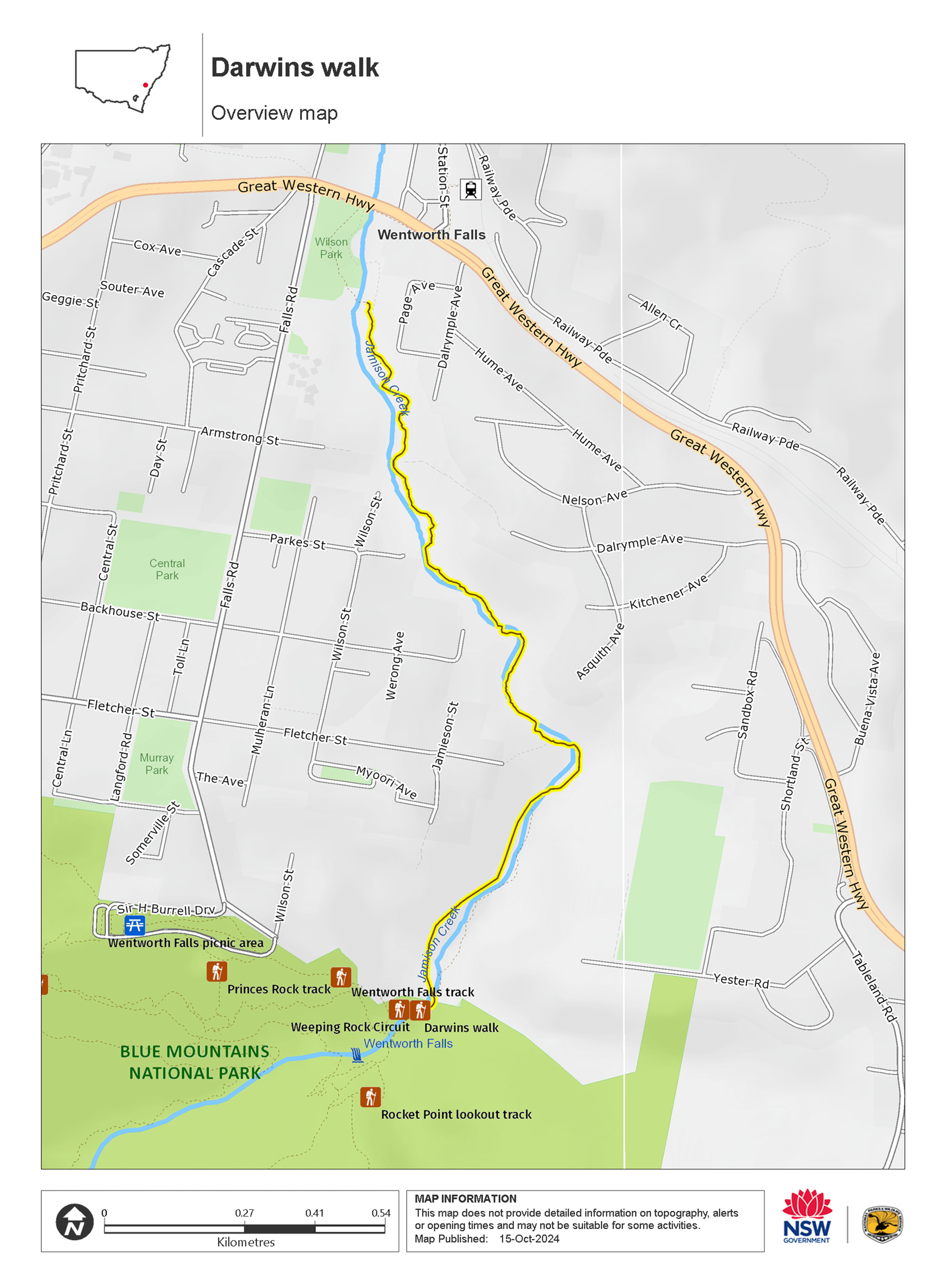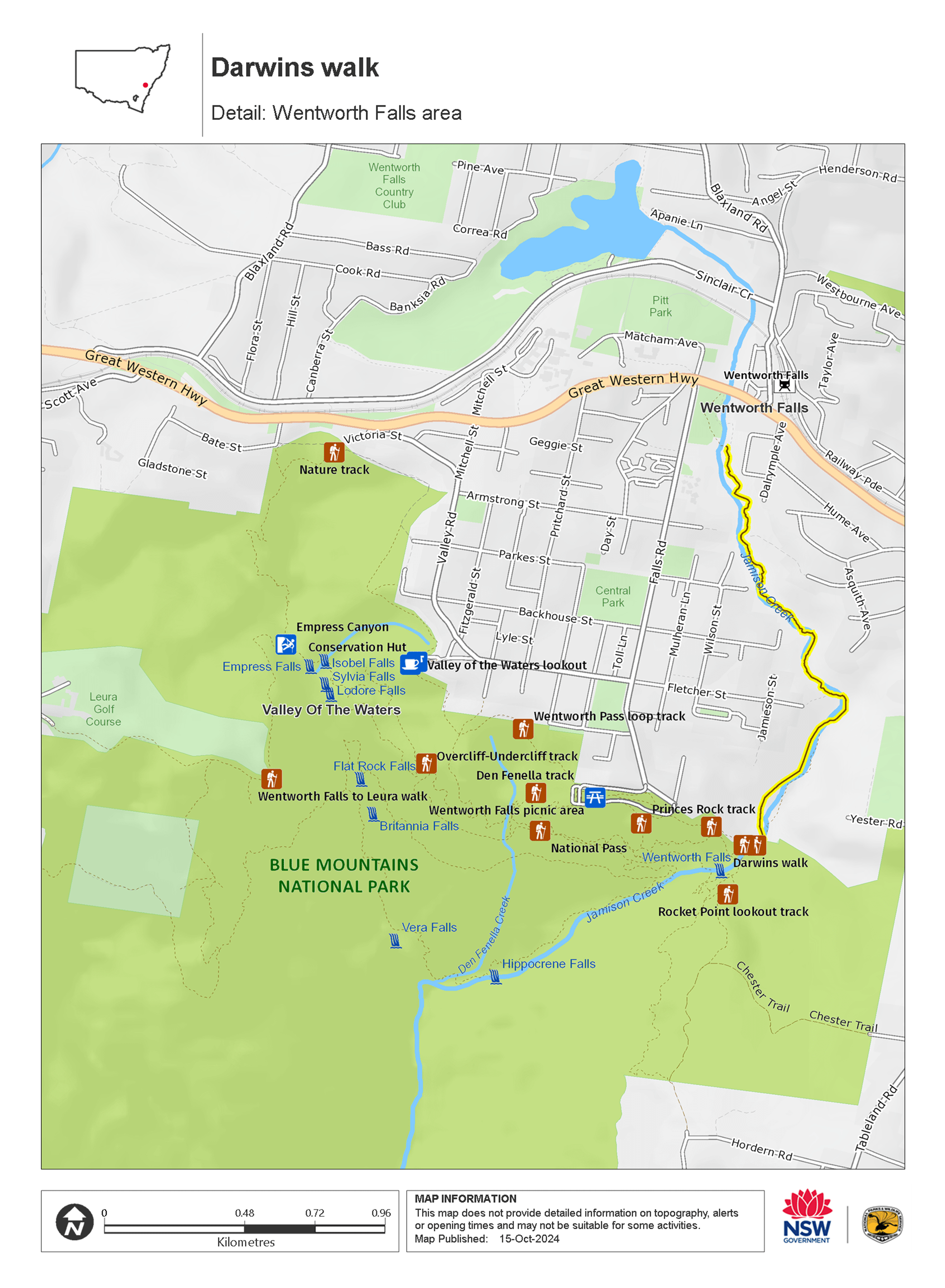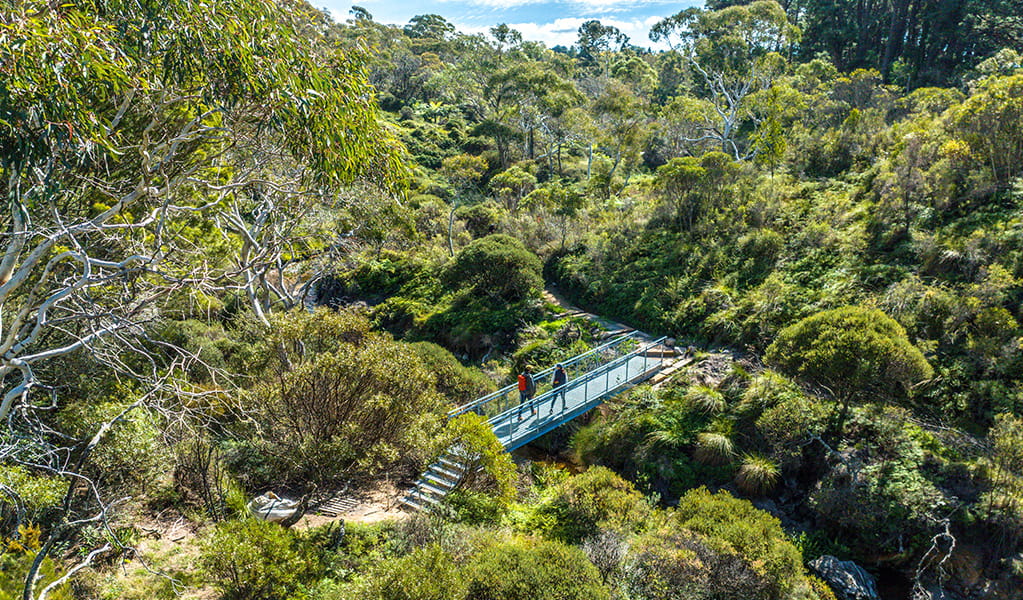Darwins walk
Katoomba area in Blue Mountains National Park
Overview
Darwins walk is an easy track that connects Wentworth Falls village with Blue Mountains National Park. Enjoy waterfalls and birdwatching as you follow Jamison Creek along this track before joining walks in the park.
- Accessibility
- No wheelchair access
- Distance
- 2.4km one-way
- Time suggested
- 45min - 1hr 15min
- Grade
- Grade 3
- What to
bring - Drinking water, hat, sunscreen, suitable clothing, sturdy shoes
- Please note
- Visit the Blue Mountains City Council website for council reserve and walking track closures.
- Please report any incidents or safety issues along this track to Blue Mountains City Council.
Darwins walk, sometimes referred to as Charles Darwin walk, is managed by Blue Mountains City Council and is located between Wentworth Falls village and Blue Mountains National Park.
Follow in the footsteps of the famous naturalist, Charles Darwin, who walked this popular track in 1836. Starting from Wilson Park, today's visitors can stroll the boardwalk and bush track through open forest, shrub, and hanging swamps to the national park boundary, where the walk meets Weeping Rock circuit track.
Along the way, Jamison Creek's rock pools and cascades are tranquil spots to cool your feet on a hot day. Bird watchers should keep an eye out for honeyeaters, shrub wrens, and the raucous black cockatoos that can't resist the native banksia trees.
From the park boundary, it's only 400m to Wentworth Falls via picturesque Weeping Rock, or 15mins to Wentworth Falls picnic area. Spend some time exploring the many walks and lookouts in the park, including Fletchers lookout, that offer incredible views of the waterfall and vast Jamison Valley, before retracing your steps back along the walk or taking Falls Road from Wentworth Falls picnic area back to town.
Darwins walk is the start of Grand Cliff Top Walk which is operated in partnership between NSW National Parks and Wildlife Service and Blue Mountains City Council
Map

Map

Map legend

Map

Map

Local alerts
For the latest updates on fires, closures and other alerts in this area, see https://www.nationalparks.nsw.gov.au/things-to-do/walking-tracks/darwins-walk/local-alerts
Park info
- in the Katoomba area of Blue Mountains National Park in the Sydney and surrounds region
Katoomba area is always open but some locations may close at times due to maintenance, poor weather or fire danger.
Visitor info
All the practical information you need to know about Darwins walk.
Track grading
Features of this track
Distance
2.4km one-way
Time
45min - 1hr 15min
Quality of markings
Clearly sign posted
Experience required
No experience required
Gradient
Gentle hills
Steps
Many steps
Quality of path
Formed track, some obstacles: The walk is mostly hard-packed ground with sections of wood boardwalk.
Getting there and parking
Get driving directions
Darwins walk starts from Wilson Park in Wentworth Falls village, just outside Blue Mountains National Park.
To get there from Sydney:
- Drive along the Great Western Highway west, towards Katoomba
- At Wentworth Falls village, turn left at the traffic lights onto Falls Road, where there is signage for Wentworth Falls and the national park
- Wilson Park is on your left, immediately after the lights, or follow Falls Road to Wentworth Falls picnic area
Road quality
- Sealed roads
Vehicle access
- 2WD vehicles
Weather restrictions
- All weather
Parking
Parking is available at:
- Wilson Park, on Falls Road
- In the national park at the Wentworth Falls picnic area carpark, including 2 accessible parking spaces.
By public transport
Regular trains run from Sydney Central Station to Wentworth Falls. Darwins walk begins in Wilson Park, 500m from the station.
Facilities
- Wilson Park, on Falls Road has parking, picnic and toilet facilities
- There is also parking, accessible toilets and picnic facilities in the national park at Wentworth Falls picnic area.
Seats and resting points
Maps and downloads
Accessibility
Disability access level - no wheelchair access
Darwins walk is a hard-packed ground track with some wood boardwalk bridges. The walk has many steps without handrails, making it unsuitable for wheelchair users, prams and mobility scooters.
There is accessible parking, accessible toilets and picnic facilities in the national park at Wentworth Falls picnic area.
Permitted
Pets
Darwins walk is managed by Blue Mountains City Council. Pets and domestic animals are permitted on this track as far as the national park boundary.
Learn more
Darwins walk is in Katoomba area. Here are just some of the reasons why this park is special:
A haven for plants and animals

Katoomba area’s diverse landscapes are home to a wide range of native plants and animals. Rare and threatened species include the yellow-bellied glider and Blue Mountains water skink. Spotted tail quolls inhabit the deep shady valleys. The ancient dwarf mountain pine, which existed in the age of dinosaurs, lives only in a 9km stretch between Katoomba and Wentworth Falls. In November and early December, keep an eye out for the pink-purple blooms of the critically endangered Megalong Valley bottlebrush, along Six Foot track.
- Blue Mountains big day out with Colourful Trips Escape the city and expand your horizons on this action-packed Blue Mountains adventure with Colourful Trips. You’ll enjoy stunning views of mountains, valleys and waterfalls, and see native wildlife too.
- Blue Mountains e-bike adventure tours Just a short hop from Sydney are mountain bike trails that thread through beautiful World Heritage-listed parkland. Explore this amazing bushland on a guided e-bike tour with Blue Mountains Biking Adventures.
- Blue Mountains escape with Daily Sydney Tours Experience the stunning World Heritage surrounds of the Blue Mountains your very own way on these fun-filled private excursions with Daily Sydney Tours.
- Blue Mountains rendezvous with kangaroos tours Explore ancient rainforests and stunning sandstone escarpments with a qualified ecology guide in World Heritage surrounds. Learn about kangaroos, wombats and other unique wildlife on this private outing with Tread Lightly Eco Tours.
- Blue Mountains tours by Australian Luxury Escapes This delightful day tour with Australian Luxury Escapes is a great way to take in wilderness views and see native wildlife in the World Heritage surrounds of Blue Mountains National Park.
In the footsteps of early tourists

The Blue Mountains boasts one of the most complex track systems of any national park in Australia. Dating from as early as 1825, around 60 per cent of the tracks have national, state or regional significance. Follow in the footsteps of early European tourists along the many historic tracks near Katoomba and Wentworth Falls, like Princes Rock walking track. Discover mining heritage along the challenging Ruined Castle route, or head down to Federal Pass, built in 1900. As you descend the Giant Stairway, spare a thought for the men who built it by hand using picks, shovels, crowbars and dynamite.
- Blue Mountains mystery tours by ghost bus Join the friendly local guides of Blue Mountains Mystery Tours for an after-dark journey by bus to explore the spine-tingling myths and legends of the Blue Mountains.
- Blue Mountains scenic day tours for small groups Enjoy a big day out to some of the most scenic locations in the Blue Mountains with the friendly guides of Oz Trails. Visit beautiful mountain villages and see stunning natural wonders in World Heritage surrounds at an unhurried pace.
- Conservation Hut Conservation Hut at Wentworth Falls is perfectly-positioned amidst the beauty of Blue Mountains National Park. Enjoy a bite to eat with uninterrupted views of the Jamison Valley and Mount Solitary.
- Federal Pass Historic Federal Pass is a challenging walk in Blue Mountains National Park. Set out from either Leura or Katoomba and enjoy views of the Three Sisters, waterfalls and Scenic World.
- National Pass National Pass is closed between Valley of the Waters and Slacks Stairs due to rockfall. From Wentworth Falls picnic area, you can walk the upper section of this loop walk, atop the escarpment, for epic lookouts with sweeping views of the waterfalls and Jamison Valley.
Ancient landscapes

The Katoomba area is one of the easiest places to see the park’s cliff walls and rock overhangs, multi-tier waterfalls and hazy blue forests. Millions of years of volcanic uplift and erosion have carved out the Jamison Valley and the Three Sisters peaks. Eagle-eyed visitors can try to spot the grey coal and shale deposits between the sandstone. These were formed 245 to 290 million years ago when this area held vast swamps and deltas. Today, landscapes range from open forest and windswept heath, to hanging swamps that cling to the cliff face, and remnant rainforest in the spray zones of waterfalls.
- All about the Blue Mountains guided tours Join All About Australian Tours to explore scenic highlights in the Blue Mountains. Departing from Sydney, these tours are a great way to soak up the beauty of this ancient landscape of river gorges, sandstone cliffs and vast eucalypt forests.
- Blue Mountains dark sky stargazing tour Join Blue Mountains Stargazing on a mesmerising 90-minute astronomy tour in the dark skies of the spectacular World Heritage-listed Blue Mountains.
- Blue Mountains escape with Daily Sydney Tours Experience the stunning World Heritage surrounds of the Blue Mountains your very own way on these fun-filled private excursions with Daily Sydney Tours.
- Blue Mountains guided photography tours Learn landscape photography in the spectacular outdoor classroom of the Blue Mountains. With a professional guide from Jaydid Photo, explore and capture the stunning beauty of this World Heritage-listed area.
- Blue Mountains rendezvous with kangaroos tours Explore ancient rainforests and stunning sandstone escarpments with a qualified ecology guide in World Heritage surrounds. Learn about kangaroos, wombats and other unique wildlife on this private outing with Tread Lightly Eco Tours.
Activities at your fingertips

Wentworth Falls picnic area was one of the first tourist facilities developed in the Blue Mountains. Today, you’ll find a viewing deck, picnic tables, accessible toilet facilities and carparks close to lookouts, waterfalls and walks. In Katoomba, enjoy the interpretative sculptures and multiple lookouts along wheelchair accessible Three Sisters walk. Combine your park experience with Scenic World attractions and the lively Katoomba street cafe scene. Kids can learn more on a school excursion or holiday activity. Why not get involved in a volunteer bushcare program.
- All-inclusive Blue Mountains guided discovery tour Explore Blue Mountains National Park in style on a discovery tour with AAT Kings. See the wildlife at Sydney Zoo, visit Scenic World, and immerse yourself in the beauty of this World Heritage-listed area.
- Blue Mountains escapes with Ready Steady Tour Let Ready Steady Tour pick you up from Sydney and whisk you away for a big day of sightseeing in the stunning World Heritage surrounds of the Blue Mountains.
- Blue Mountains highlights tour with FJ Tours Take a coach tour with FJ Tours to see the highlights of Blue Mountains National Park. You’ll visit Featherdale Wildlife Park, Echo Point and Jamison Valley before taking a river cruise back to Sydney.
- Blue Mountains tours with Activity Tours Australia Explore Blue Mountains National Park away from the crowds on a small group tour with Activity Tours Australia. You’ll discover secluded lookouts, remote waterfalls and hidden valleys on this flexible day trip.
- Conservation Hut Conservation Hut at Wentworth Falls is perfectly-positioned amidst the beauty of Blue Mountains National Park. Enjoy a bite to eat with uninterrupted views of the Jamison Valley and Mount Solitary.
Greater Blue Mountains Area World Heritage Property

Blue Mountains National Park is 1 of 8 national parks and reserves that make up the World Heritage listed Greater Blue Mountains Area (GBMA). In 2000, UNESCO recognised the area's outstanding biodiversity significance. The GBMA lies within the Country of the Dharug, Gundungurra, Wiradjuri, Darkinjung, Wanaruah and Dharawal People. With over 1 million hectares of rugged plateaux, sheer cliffs and deep gorges, it protects unique ecosystems teeming with rare plants and animals. Over 99 species of eucalypt trees have evolved here over millions of years, making it the most diverse eucalypt forest in the world. Greater Blue Mountains Drive is a great way to see this ancient wilderness right on Sydney doorstep.
- All about the Blue Mountains guided tours Join All About Australian Tours to explore scenic highlights in the Blue Mountains. Departing from Sydney, these tours are a great way to soak up the beauty of this ancient landscape of river gorges, sandstone cliffs and vast eucalypt forests.
- Blue Mountains Aboriginal culture tour Join Zanza Tours and escape the city for a day of discovery in the beautiful Blue Mountains. You’ll experience a traditional Aboriginal ceremony, local food and amazing scenery in World Heritage surrounds.
- Blue Mountains big day out with Colourful Trips Escape the city and expand your horizons on this action-packed Blue Mountains adventure with Colourful Trips. You’ll enjoy stunning views of mountains, valleys and waterfalls, and see native wildlife too.
- Blue Mountains dark sky stargazing tour Join Blue Mountains Stargazing on a mesmerising 90-minute astronomy tour in the dark skies of the spectacular World Heritage-listed Blue Mountains.
- Blue Mountains e-bike adventure tours Just a short hop from Sydney are mountain bike trails that thread through beautiful World Heritage-listed parkland. Explore this amazing bushland on a guided e-bike tour with Blue Mountains Biking Adventures.
Plants and animals protected in this park
Animals
-

Superb lyrebird (Menura novaehollandiae)
With a complex mimicking call and an elaborate courtship dance to match, the superb lyrebird is one of the most spectacular Australian animals. A bird watching must-see, the superb lyrebird can be found in rainforests and wet woodlands across eastern NSW and Victoria.
-

Wedge-tailed eagle (Aquila audax)
With a wingspan of up to 2.5m, the wedge-tailed eagle is Australia’s largest bird of prey. These Australian animals are found in woodlands across NSW, and have the ability to soar to heights of over 2km. If you’re bird watching, look out for the distinctive diamond-shaped tail of the eagle.
-

Yellow-tailed black cockatoo (Calyptorhynchus funereus)
The yellow-tailed black cockatoo is one of the largest species of parrot. With dusty-black plumage, they have a yellow tail and cheek patch. They’re easily spotted while bird watching, as they feed on seeds in native forests and pine plantations.
-

Eastern water dragon (Intellagama lesueurii lesueurii)
The eastern water dragon is a subaquatic lizard found in healthy waterways along eastern NSW, from Nowra to halfway up the Cape York Pensinsula. It’s believed to be one of the oldest of Australian reptiles, remaining virtually unchanged for over 20 million years.
-

Kookaburra (Dacelo novaeguineae)
Of the 2 species of kookaburra found in Australia, the laughing kookaburra is the best-known and the largest of the native kingfishers. With its distinctive riotous call, the laughing kookaburra is commonly heard in open woodlands and forests throughout NSW national parks, making these ideal spots for bird watching.
-

Short-beaked echidna (Tachyglossus aculeatus)
One of only 2 egg-laying mammals in the world, the short-beaked echidna is one of the most widespread of Australian native animals. Covered in spines, or quills, they’re equipped with a keen sense of smell and a tube-like snout which they use to break apart termite mounds in search of ants.
Plants
-

Old man banksia (Banksia serrata)
Hardy Australian native plants, old man banksias can be found along the coast, and in the dry sclerophyll forests and sandstone mountain ranges of NSW. With roughened bark and gnarled limbs, they produce a distinctive cylindrical yellow-green banksia flower which blossoms from summer to early autumn.
-

Grass tree (Xanthorrea spp.)
An iconic part of the Australian landscape, the grass tree is widespread across eastern NSW. These Australian native plants have a thick fire-blackened trunk and long spiked leaves. They are found in heath and open forests across eastern NSW. The grass tree grows 1-5m in height and produces striking white-flowered spikes which grow up to 1m long.
-

Scribbly gum (Eucalyptus haemastoma)
Easily identifiable Australian native plants, scribbly gum trees are found throughout NSW coastal plains and hills in the Sydney region. The most distinctive features of this eucalypt are the ‘scribbles’ made by moth larva as it tunnels between the layers of bark.
-

Smooth-barked apple (Angophora costata)
Smooth-barked apple gums, also known as Sydney red gum or rusty gum trees, are Australian native plants found along the NSW coast, and in the Sydney basin and parts of Queensland. Growing to heights of 15-30m, the russet-coloured angophoras shed their bark in spring to reveal spectacular new salmon-coloured bark.
-

Waratah (Telopea speciosissima)
The beautiful waratah is not only the NSW floral emblem, it's also one of the best-known Australian native plants. This iconic Australian bush flower can be found on sandstone ridges around Sydney, in nearby mountain ranges and on the NSW South Coast. The waratah has a vibrant crimson flowerhead, measuring up to 15cm across, and blossoms in spring.
Environments in this area
School excursions (5)
- Explore a national park, Stage 2 (Years 3-4), Geography
- Living Country, living culture, Stage 2 (Years 3-4), History
- Mountain landscapes: Blue Mountains, Stage 4 (Years 7-8), Geography
- Rainforests and waterfalls, Stage 3 (Years 5-6), Geography
- Living Country, living culture, Stage 1 (Years 1-2), Geography

